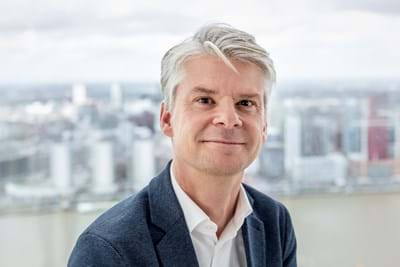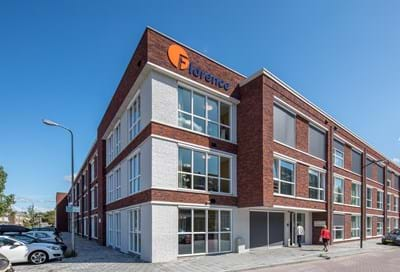- Home EN
- News
- Latest news
- 2021
- Blauwhoed targets ‘neglected’ active seniors for its development activities
Blauwhoed targets ‘neglected’ active seniors for its development activities
Dutch developer Blauwhoed has identified ‘neglected’ active seniors as a growing target group that has traditionally been overlooked by other market participants. Not only has the Rotterdam-based developer recognised the scale of the problem, it is also doing something about it. The company has developed a 'Senior Smart Living' concept and has now launched this in the Dutch market. The response to the first completed projects has been very enthusiastic, Blauwhoed Director Eltjo Bouwman explains in an interview.

The ‘double-aging’ effect of the Dutch population is one of the demographic factors that is set to have a major impact on the country’s housing market in the coming decades: First, the size of the elderly group living in either single or two-person households is forecast to grow, and second many of them will live longer than previous generations. Pressure will rise on regular housing stock to meet most of this demand since the number of dedicated nursing and elderly-care homes has been reduced significantly in recent years. As the supply of suitable accommodation is very limited, many seniors understandably feel that the effort of moving house is simply not worth it. Most elderly people therefore remain in their current homes despite the fact they are often far too large for them after their children have left the nest.
Blauwhoed identified this mismatch a number of years ago and has since focused on developing residential accommodation that explicitly caters to the living requirements of active seniors. The company discovered that many older people do actually want to move, provided their new accommodation fulfils all their needs. Eltjo Bouwman shares tips for investors like Bouwinvest who are interested in this market.
Blauwhoed is one of the few property developers in the Netherlands to focus explicitly on housing for seniors. What prompted this strategy?
“We had already been talking to potential customers for some time about our 'Senior Smart Living' concept, but our plans became concrete when we started working on a project in Schiedam: ParkEntree. The goal of this development was to create a living environment where active seniors could live together independently with shared facilities for meetings, exercise and other activities. We identified a group of seniors who wanted to work with us on this project, which is now built and operational. It offers a wide variety of accommodation, collective spaces and facilities as well as a manager who is responsible for all kinds of activities. The concept clearly fulfilled a need among a group of over 60s who were still healthy and active and willing to move, provided that the offering was sufficiently attractive and that any long-term care requirements would be met on a flexible basis.”
In your communication, you call this target group a 'neglected’ one - does that partly explain why there is now such a great shortage of housing for seniors?
“The population is ageing, a trend that is clearly accelerating. Many urban planners still have an image of the traditional population pyramid where there are more children than seniors, but this has been turned on its head which nobody really anticipated. One of the consequences is that the existing housing stock is skewed towards regular family homes. In our experience, seniors are quite willing to move, and that latent demand is substantial. But they only want to move to an attractive home in an area that has the right facilities.
This group is understandably extremely critical. They have accumulated years of ‘living’ experience - and they have a choice. Any decision they make will be voluntary so the alternative must be worthwhile. When we were working on ParkEntree, a lot of people said the same thing: that they didn't actually have any concrete plans to move, but that this project got them thinking so they decided to take the plunge. The target market is large and growing. Take a city like Utrecht, for example. The number of inhabitants there aged over 65 is set to increase from 21,800 today to 64,000 in 2040. In Amsterdam, the picture is very similar: the number of seniors living there is soon set to rise to 160,000 people. In other words, it’s not just our villages that are ageing, our cities are too.”

Why is so little attention paid to this group?
“Good question. Perhaps because planners make the wrong assumption about them: that they don’t want to move. Maybe it’s less sexy? Or maybe developers think you can’t generate an attractive return on this type of project? You name it. Our experience is that seniors are financially well-resourced but they do not want to be associated with ‘care home’ concepts. They are still very active in society and the idea of needing ‘care’ is taboo for them. Their main concern is wellbeing. They want to enjoy life, travel, spend time on their hobbies. And if they need care in the long run, it must be easily accessible. We thought this was an interesting market dynamic. This is a critical decision for them - and rightly so. This move may well be their last one, so everything must be just right. They want to be involved in co-creating their new accommodation, they need to be seduced. Maybe that’s why this target group has slipped between the cracks.”
Newly built homes for this group are an interesting alternative for seniors but are there any other advantages for the housing market as a whole?
“We must always be clear about what type of new buildings we add to the existing housing stock in the Netherlands, as space comes at a premium. There must be a definite need and it must help movement through the existing supply. If suitable accommodation is made available for seniors we would see more rotation of existing housing stock. The existing family homes that would then become available are in strong demand, and as families leave other types of housing, this would start the entire chain moving leading to more affordable homes becoming available. By specifically targeting seniors with purpose-built accommodation, we can free up far more family homes than we could by building this type of housing from scratch.”
Can you describe the main features of the 'Senior Smart Living' concept Blauwhoed is now marketing?
“It is intended for seniors who still want to develop and meet others. First, we organise joint design sessions with interested parties which create an initial group vibe and allow people to get to know each other. Then we look at the physical accommodation, the outdoor space and gardens, the shared facilities and the possibilities of developing activities together. The software is really just as important as the bricks.”

How do you view collaborating with parties like Bouwinvest?
“I think there are some very good opportunities for cooperating at an agenda-setting level. Because development sites are scarce, our aim is to develop a complementary offer for the entire chain. Our projects primarily target the preventative side of care for seniors and we work with partners if specialist services such as dementia care are required as we don’t provide this ourselves. In Leidschendam, for example, we developed a building acquired by Bouwinvest where specialist care provider Stichting Florence is the tenant. We always ensure that the care apartments we build are suitable for all phases of life including the final one. The 'Senior Smart Living' group is also an attractive target demographic for an investor like Bouwinvest, which has a long-term perspective and is looking for stable income returns. Parties such as municipalities also play an important role. They need to give seniors a prominent place in their housing policies and take this group into account when allocating land and selecting partners.”

